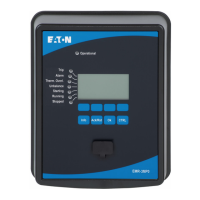desirable to directly transfer the setting value from one device to another; the TCP/IP
settings are an example for this.)
There are several types of parameters, depending on the type of data they can hold.
For the user, it is not necessary to know details, but it can be good to know that
there are numerical parameters (e. g. overcurrent thresholds) and parameters which
hold one option out of a selection list. These select options can either be xed values
(e. g. the choice of communication protocol), or they can be a signal (so that during
run-time, the actual parameter value equals the state of the assigned signal). This
case of a signal assignment is what has been mentioned above as a “module input”.
•
Some parameter properties depend on the value of particular other parameters. For
example, the “device planning” parameters (in the [Device Planning] menu) do not
only activate or deactivate protection functions but also control the visibility of their
related parameters.
Some parameters depend on others not only with respect to visibility, but also
default values and/or available value ranges. (For example, the range of some
protection parameters depend on the CT ratio.)
Direct Commands
• Direct Commands are part of the “menu tree”, just like a setting parameter, but
they are meant to be executed immediately. Therefore Direct Commands are NOT
part of a *.ErPara parameter le.
Typical examples are the Direct Commands for resetting Counters.
On the panel (and on a listing window of PowerPort-E), Direct Commands are marked
by a special “push button switch” symbol “⊙”, so that the user can immediately
recognize them.
Signals
• Signals are run-time states, i. e. depend on the result of a protection function or on
the state of a Digital Input.
Signals are part of the “menu tree”. They can all be found in the menu path
[Operation / Status Display].
• Some Signals represent the state of the installation/equipment (e. g.: position
indicators of the breaker).
• Some Signals are assessments of the state of the grid and the equipment (e. g.:
System OK, Transformer failure detected).
• Some Signals represent decisions that are taken by the device (e. g.: Trip Command)
based on the parameter settings.
• Many signals can be assigned to particular parameters. This means the function of
this parameter depends on the run-time state of the signal.
For example, every protection function features several blocking parameters. (See
also ╚═▷ “Blockings”.) If a signal has been assigned to a blocking parameter then
the respective protection function gets blocked as soon as the run-time state of the
assigned signal becomes “True”.
29www.eaton.comEMR-3MP0
1 EMR‑3MP0 Motor Protection Relay
1.3 Modules, Settings, Signals and Values

